四川大学硕士学位论文
四川大学关于学位(毕业)论文抄袭、剽窃等学术不端行为的处理办法(试行)(川大校〔2010)2号

关于印发《四川大学关于学位(毕业)论文抄袭、剽窃等学术不端行为的处理办法(试行)》的通知川大校〔2010〕2号校内各单位:为维护学术尊严,规范学术行为,加强校风学风建设,促进我校学术研究健康发展,根据国家有关法律法规、教育部有关文件精神和学校相关文件规定,在已经实施的《四川大学学术道德规范》和《四川大学关于违反学术道德规范的处理规定》的基础上,学校制定了《四川大学关于学位(毕业)论文抄袭、剽窃等学术不端行为的处理办法(试行)》,现印发给你们,请认真学习,并遵照执行。
附件:四川大学关于学位(毕业)论文抄袭、剽窃等学术不端行为的处理办法(试行)四川大学二○一○年一月二十一日主题词:学术行为规范办法通知四川大学校长办公室二○一○年一月二十九日印发打字:贾盛庆校对:秦远清印数:500份附件2四川大学关于学位(毕业)论文抄袭、剽窃等学术不端行为的处理办法(试行)第一条指导思想为维护学术尊严,规范学术行为,保障学术自由,加强我校校风学风建设,促进我校学术研究健康发展,依据《中华人民共和国著作权法》、《中华人民共和国著作权法实施细则》、教育部《关于树立社会主义荣辱观进一步加强学术道德建设的意见》、《关于严肃处理高等学校学术不端行为的通知》等法律法规、文件,并在我校已经出台实施的《四川大学学术道德规范》、《四川大学关于违反学术道德规范的处理规定》的基础上,学校决定进一步加强对学位(毕业)论文的规范管理,防范和惩治学位(毕业)论文抄袭、剽窃等学术不端行为,特制定本办法。
第二条适用范围本办法适用于攻读我校学位(指博士、硕士、学士学位)的研究生、本科生等撰写的以我校为著作权人单位的学位(毕业)论文。
我校教职工和学生都应严格遵守学术规范,恪守学术道德,弘扬优良学风,杜绝学术不端。
本办法专门针对学位(毕业)论文中的抄袭、剽窃等学术不端行为进行认定和处理,其它学术不端行为按《四川大学学术道德规范》和《四川大学关于违反学术道德规范的处理规定》处理。
头孢菌素类抗生素的的构效构动关系及分子设计
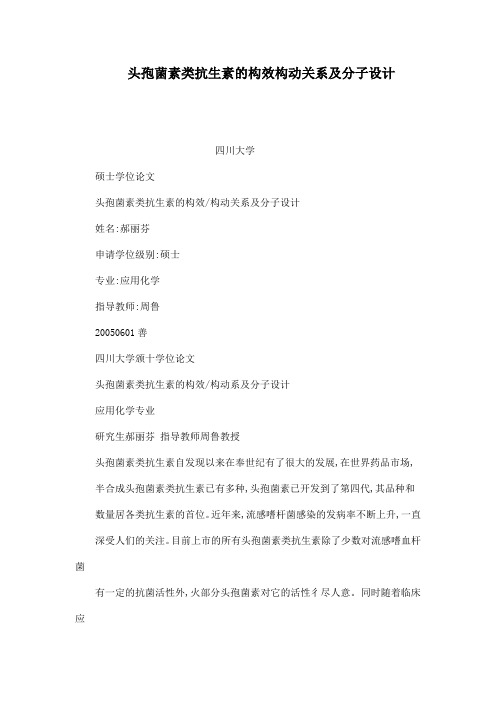
头孢菌素类抗生素的构效构动关系及分子设计四川大学硕士学位论文头孢菌素类抗生素的构效/构动关系及分子设计姓名:郝丽芬申请学位级别:硕士专业:应用化学指导教师:周鲁20050601善四川大学颁十学位论文头孢菌素类抗生素的构效/构动系及分子设计应用化学专业研究生郝丽芬指导教师周鲁教授头孢菌素类抗生素自发现以来在奉世纪有了很大的发展,在世界药品市场, 半合成头孢菌素类抗生素已有多种,头孢菌素已开发到了第四代,其品种和数量居各类抗生素的首位。
近年来,流感嗜杆菌感染的发病率不断上升,一直深受人们的关注。
目前上市的所有头孢菌素类抗生素除了少数对流感嗜血杆菌有一定的抗菌活性外,火部分头孢菌素对它的活性彳尽人意。
同时随着临床应用的普及和增长,头孢菌素类抗生素不良反应的发生率也逐渐增多,如致敏反应、造血系统功能障碍、二重感染及肝脏和肾毒性等。
急需设’和寻找出抗菌活性更强、安全性更高的头孢菌素新药。
因此对头孢菌素的药效学/药动学性质,抗菌作机理和化合物分子结构之间的关系做深入研究,可以为设计和寻找新药提供参考和帮助。
本文利用量子化学方法和神经网络方法,进行了头孢菌素类抗生素的分子结构参数计算以及药效学药动学参数弓其分了结构参数之间的和建模。
本文搜集了已有实验报道的种头孢菌素类抗生素的流感嗜血杆菌的最小抑菌浓度作为本文研究的药效学指标。
运用量子化学算法计算了此种头孢菌素类抗牛素的个结构参数。
由相关性分析从中筛选出与头孢菌素的药效学指标榍哭性较大的个结构参数作为稗经网络的输入参数。
利用误筹反向传播的神经网络,训练函数选用?的快速学习算法来构建头孢菌素类抗生素的模型,从个头孢菌素样本中,随机抽取了个样本作为训练集,剩余的作为检验集来验证模型的预测效果,结果表明模型的训练和预测效果较好,说明本文筛选的结构参数和建立的头●四川大学硕十学位论文孢菌素的模型是较为合理的,侄一定程度上体现了该类抗生素的抗菌活性变化规律。
另外,本文还搜集了已有实验报道的种头孢菌素类抗生素的五个药动学参数Ⅱ、‘】口卧、和。
四川大学硕士学位论文格式

四川大学硕士学位论文格式一篇规范的学位论文应包含以下几项内容:1、论文中、英文摘要2、目录3、综述4、正文5、结论6、参考文献7、作者在读期间科研成果简介8、申明论文内容独创性,并注明论文成果属四川大学所有。
由指导教师和学生同时签名有效。
9、致谢。
第一章学位论文格式要求1.1页面设置n纸张:A4,页边距:左右各2.5cm,上2.75cm,下2.5cm;页眉/页脚:1.75 cm/1.75 cm页眉文字:单数页为本章题目,比如:第一章液膜传质理论(小五号字,宋体)双数页文字为:四川大学工程(或工学)硕士学位论文(小五号,宋体)1.2 正文格式1.2.1 正文标题格式一级标题即每章题名,字号:三号,字体:黑体,设在单数页面开头二级标题,字号:四号,字体:黑体,其中注意:阿拉伯数字用TNR字体三级标题,字号:小四号,字体:黑体,其中注意:阿拉伯数字用TNR字体四级标题,字号:小四号,字体:楷体体,其中注意:阿拉伯数字用TNR字体注意:TNR字体指Times New Roman字体。
一级标题居中,其余标题左对齐,除四级标题外,其余标题前需空一行,若下级标题紧接上一级标题,则下级标题前空半行或不空行,Times New Roman1.2.2 正文内容格式行距,固定值:20磅,段前段后:0行注意:如果文中有分段序号,则序号必须有括号,比如:(1),(2)或①,②等1.3 公式格式1.3.1 公式位置不带编号公式,直接采用居中格式,注意去掉公式前的空格带编号公式,公式居中,编号右靠齐,编号格式:(各章序号-公式序号),例如(3-2)微分符号:所有公式中的微分符号“d”均为正体。
公式为正文内容,通常其后的参数说明应提行顶格1.3.2 公式字体及字号所有单位:均采用正体,直接键入或在公式编辑器中采用文字格式输入所有变量:均采用斜体,数字下标采用正体,英文下标采用斜体所有公式字号采用12磅,段前0.5行,段后0行,1.5倍行距1.4 图表格式1.4.1 表格所有表格采用三线表,表格总宽度不能超过页面宽度,必须在页面范围内。
Counsell卒中预后模型的临床应用价值探究

四川大学硕士学位论文Counsel Ⅰ卒中预后模型的临床应用价值研究姓名:赵晓玲申请学位级别:硕士专业:神经病学指导教师:刘鸣20030508四川大学硕士研究生论文CounselI卒中预后模型的临床应用价值研究研究生赵晓玲导师刘鸣教授摘要背景和目的:卒中预后模型有诸多作用。
但在临床应用前必须评价这些预后模型的真实性、可靠性及临床应用价值。
最近发表的Counsell系列卒中预后模型已被某些研究证实有较好的内在和外在真实性,但因对其外在真实性的研究尚不充分,目前还未在临床推广应用。
本研究采用我院脑卒中患者的I临床资料,对Counsell系列7个模型的外在真实性和临床应用的可行性进行研究,旨在了解该模型的临床应用价值。
同时也为今后国内建立、验证和评价卒中预测模型的研究提供思路。
方法:对2002年3月1日--2003年3月1日一年内连续入住四川大学华西医院神经内科的卒中住院患者进行前瞻性登记。
对登记的564例患者前瞻性收集、记录Counsell模型使用的23个预测变量信息,分别于发病后30天和6个月盲法随访患者的生存和改良Rankin量表(MRS)评分情况。
将患者数据分别代入7个模型计算出患者发生结局事件的概率,与通过随访得到的真实结局概率进行比较,了解模型预测的准确性。
使用ROC曲线和曲线下面积以及Calibration校准线评价模型的外在真实性和临床应用价值。
结果:7个模型的曲线下面积在0.840—0.868之间,均>o.80,提示各模型的分辩力均较好。
各模型曲线下面积之间没有统计学差异(P>O.05),因此纳入变量数目较少的模型4和模型5分别被本研究确定为预测30天生存和6月生存且独立的最佳模型。
这两个模型均仅有6个预测变量:年龄,独自生活,病前独立生活,GCS言语评分正常,可以抬举双臂和可以行走。
用模型4和模型5分别对年龄、就诊时间进行分层分析,结果显示,两个模型对各层患者结局的分辨力无差异,但对卒中类型的分层结果显示,两个模型对出血性和缺血性患者结局的分辨力有差异;校准曲线(Calibration线)显示根据各模型计算出的结局事件的概率(预测概率)与实际概率基本接近(各点均在450对角线附近),说明各模型的校准度均较好。
四川大学硕士论文格式
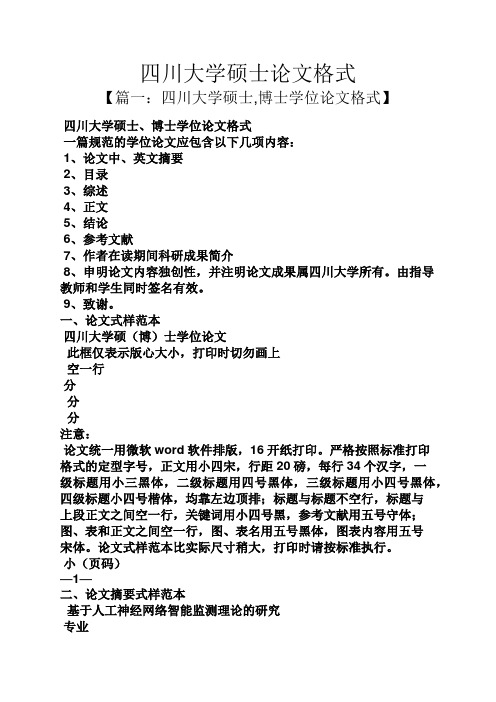
(6)最后再将插入的引用标注改为上角标即可。
【注意】使用上面插入交叉引用方法时,当参考文献有更新(如插入/删除项),引用不能自动更新,需将受影响的标注项重新标注。若使用插入尾注的方法,当标注添加后,无论是对标注还是参考文献的改动,word都会自动同步,但这种方法需要自己调整参考文献序号的所需格式。
四川大学工程硕士学位论文工商电子政务实践与研究
1综述
改革开放以来,我国国民经济正逐步向着健康、??
1.1系统编写目的
本方案是为《成都市企业信用信息系统建设》项目所设计??
1.2系统建设背景
信息技术的飞速发展正引发着一场深刻的生产和生活方式的变革[1],极大地推动着??
3+4+5+6+2=20
(1-1)
(4)关于“总结与展望”
对研究工作要有总结:取得的成果(或工程实施完成情况)、存在
的问题、深入的研究方向或下一步的研究工作等等。
(5)关于论文中的参考文献引注问题
论文中,从“概述”开始,所有的叙述、分析、论证、结论等,其用语都必须准确、严格、科学、符合逻辑。杜绝一切似是而非、道听途说、猜测意想的叙述。论文中所使用的重要论述、结论、数据必须有确切的根据,并在所引用的文字末尾用带方括符的数字上标指明所引用的文字取自参考文献中的哪篇文献。例如:“基于osi参考模型的七层协议之上的信息安全体系结构,一般可以用iso 7498-2三维图来描述[5]。”
工程项目的需求分析(或系统设计要求、技术指标等)、系统设计与实现方案、系统测试,或工程实施、系统运行中的问题和解决办法等内容;
对于工程设计与实现项目,论文正文中要有系统测试(包括测试方
案、测试计划、测试结果等)以及系统运行情况等方面的内容或章节。
SEBS熔融接枝马来酸酐及其接枝机理研究

四J11人学硕I学位论殳
成相区分散于弹性基体相中,并将弹性体嵌段锁接成物理交联的网络【11(图
1—2)。
弹性体
相区
Fig.1-2 Phase Structure ofSEBS
SEBS这种独特的三嵌段分子结构赋予了它的多用途特性。以弹性体为 连续相.聚苯乙烯为分散相的网络结构赋予了SEBS与传统硫化橡胶相似的 弹性,具有塑料和橡胶的双重性质。在非动态用途方面可与乙丙橡胶媲美, 不需要硫化就有橡胶的优良应用性能,而且可以像热塑性塑料加工成型,边 角余料可循环回用而不损害其物性和加工性能。使用中具有较好的耐磨性和 柔韧性,此外还具有优异的电气绝缘性,所以SEBS在很多方面都有广泛应
SEBS with maleic anhydride(MAH)and initiator by a twin-screw extruder was descried.It
is confirmed that MAH has grafted on SEBS by means of FTIR.The graft degme and
SEBS melt grafting MAH,analyzing the progress of the reaction of SEBS melt grafting MAH The results show that the grafting process
is divided four steps.Stage number as follows:1,O.8246,O.9775,
0.9689.
2
It is confirmed that MAH has grafted on SEBS by means of FTIR.
The graft degree and efficiency of SEBS··g-MAH was determined by
D半乳糖诱导生物体衰老与细胞衰老模型的实验研究
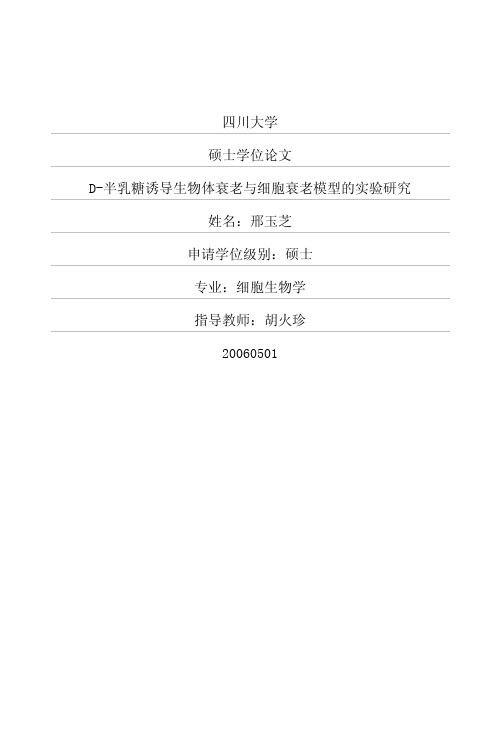
1. animal aging:The normal control had many significant differences from
the model group in constitutional and action.eg:The model group
D—gal group. gonc l us i ons D--galatose can inducted mice and mesenchymal stem cells
6
婴型奎兰塑主兰竺堡苎
senescence,and 89n was the best.Thus this study provides a good model of rat
Mayor.Ceil-biology
Cn"adtlate Student:Xing Yu—zhi
Supervisor:.Prof.Hu Huo-zhen
Abstract
Objective Our study focused on research the correlation among the oxidative damage.stem cell senescene and animal aging.by me越u砖the quantity of free radical,morphological and biological changes of animal and ceil model.We want tO explains that D-galaetose inducing subacuw aging
4.the detection of senescencive signs:Optical and electronic microscope,
胫骨前肌腱的应用解剖探究

四川大学临床医学硕士专业学位论文胫骨前肌腱的应用解剖研究研究生:王林强导师:彭明惺教授摘要目的:观察固人胫骨前肌腱止点,长度,营养血供,为临床应用提供解剖学依据。
方法:采用国人尸体足及小腿标本46侧,进行灌注,并解剖胫骨前肌腱性部分:(1)观测胫骨前肌踺止点,分布及变异情况:(2)观{91II胫骨前肌腱内外踝突连线以下氏度;(3)对3侧动脉灌注较好的标本,进行胫骨前肌腱滑膜囊段及囊外段血供的肉眼和组织学观察。
结果:(1)根据46侧胫骨前肌腱止点的形态,分布特点,分为三型:1型为束状型,共28侧(60.87%),呈单一条束状,止于足内侧的第一楔骨远端和第一跖骨基底;II型为中间型,共14侧(30.43%)隐约可见两束肌腱组成一束的肌腱止点,外观呈扇状分布,止点位冒与前者相同;III型为分叉型,共4侧(8.7%),外观呈分叉状,有两条各自分开的止点。
(2)胫骨日口胍腱在内外踩突连线以下跃度:40侧成人为72.33±5.29ram:6侧儿奄为56.77±4.54mm。
(3)肉眼可见:胫前动脉及其分支如足背动脉等分成若干小支与肌腱走向呈垂直方向或一定角度进入胫骨前肌腱的滑膜囊段及远端囊外紧靠肌腱周围的疏松结缔组织中。
肌腱横断面的镜下观察:束状型可见帆管束分布于腱膜上,并进入腱束MI但不进入束内;中间型肌腱可见两束之间腱膜卜仃m管止行。
结论:(1)胫骨自U肌胜止点形态的多样化,其小点形念分伽存在变异,尤其以分叉型为明显,其变异率达8.7%,临床}:若f}{现变异病例,采用常规切断该肌腱止点的手术切口,难以充分暴露所有肌腱JJ:点,宜适当扩大原切口,甚至另作切口,以确保全部肌腱止点均被完伞切断。
(2)¨J_供转位的胫督’前肌腱长度,无论小儿或成人变化均较大,进行该肌腱转位术时,应认真面对陔肌腱过长尤其过短的手术操作要求,以确保转位后肌腱松紧度合适。
(3)在脐骨前肌腱转位的手术过程中,应尽可能保护该肌腱滑膜囊的完整性以及陔肌腱的血供来源,这是提高术后肌腱康复质量的重要操作技术之,一。
2018-128论文格式要求-专业硕士-四川大学
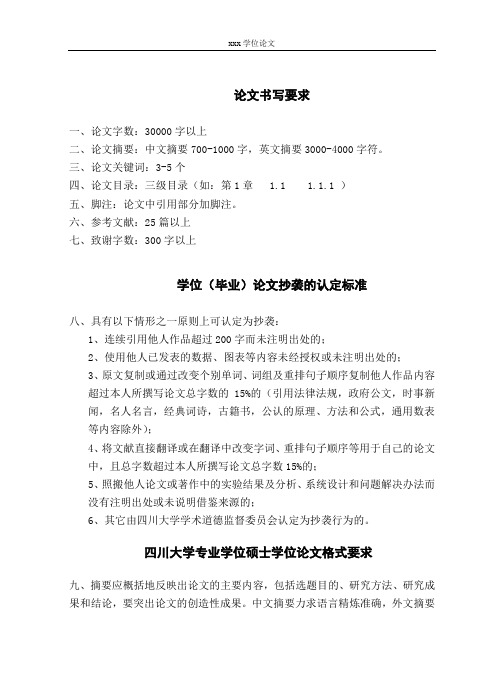
论文书写要求一、论文字数:30000字以上二、论文摘要:中文摘要700-1000字,英文摘要3000-4000字符。
三、论文关键词:3-5个四、论文目录:三级目录(如:第1章 1.1 1.1.1 )五、脚注:论文中引用部分加脚注。
六、参考文献:25篇以上七、致谢字数:300字以上学位(毕业)论文抄袭的认定标准八、具有以下情形之一原则上可认定为抄袭:1、连续引用他人作品超过200字而未注明出处的;2、使用他人已发表的数据、图表等内容未经授权或未注明出处的;3、原文复制或通过改变个别单词、词组及重排句子顺序复制他人作品内容超过本人所撰写论文总字数的15%的(引用法律法规,政府公文,时事新闻,名人名言,经典词诗,古籍书,公认的原理、方法和公式,通用数表等内容除外);4、将文献直接翻译或在翻译中改变字词、重排句子顺序等用于自己的论文中,且总字数超过本人所撰写论文总字数15%的;5、照搬他人论文或著作中的实验结果及分析、系统设计和问题解决办法而没有注明出处或未说明借鉴来源的;6、其它由四川大学学术道德监督委员会认定为抄袭行为的。
四川大学专业学位硕士学位论文格式要求九、摘要应概括地反映出论文的主要内容,包括选题目的、研究方法、研究成果和结论,要突出论文的创造性成果。
中文摘要力求语言精炼准确,外文摘要以反映中文摘要内容为限。
建议中文摘要1000字以内。
摘要中不要出现图片、图表、表格或其他插图材料,尽量用纯文字叙述。
关键词一般3~5个。
十、论文摘要严格按打印格式的字型字号,如题目用小二号宋体居中,专业用小四号宋体居中,“研究生”和“指导教师”用小四号黑体,研究生姓名和指导教师姓名用小四号楷体,“摘要”两个字用四号黑体,居中。
正文用小四号宋体,“关键词”三个字用小四号黑体,词与词之间空两个汉字符。
(标题上空二行,标题与专业之间空一行,专业与姓名之间空一行,姓名与“摘要”空一行,“摘要”与正文空一行,正文与关键词空两行。
四川大学硕士学位论文格式1
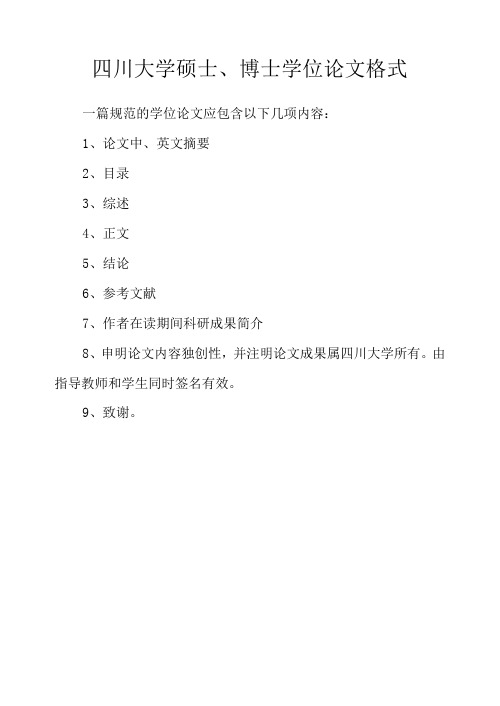
四川大学硕士、博士学位论文格式一篇规范的学位论文应包含以下几项内容:1、论文中、英文摘要2、目录3、综述4、正文5、结论6、参考文献7、作者在读期间科研成果简介8、申明论文内容独创性,并注明论文成果属四川大学所有。
由指导教师和学生同时签名有效。
9、致谢。
一、论文式样范本四川大学硕(博)士学位论文此框仅表示版心大小,打印时切勿画上论文统一用微软Word 软件排版,16开纸打印。
严格按照标准打印格式的定型字号,正文用小四宋,行距20磅,每行34个汉字,一级标题用小三黑体,二级标题用四号黑体,三级标题用小四号黑体,四级标题小四号楷体,均靠左边顶排;标题与标题不空行,标题与上段正文之间空一行,关键词用小四号黑,参考文献用五号守体;图、表和正文之间空一行,图、表名用五号黑体,图表内容用五号宋体。
论文式样范本比实际尺寸稍大,打印时请按标准执行。
小(页码)空一行分 分 分二、论文摘要式样范本基于人工神经网络智能监测理论的研究专业研究生指导教师刀具故障的在线监测理论和技术是现代切削加工技术中的重要研究课题之一,对于先进制造技术的发展具有重大意义。
本文主要对人工神经网络技术在非线性映射,模式分类和智能监测中的应用,光纤传感在线监测深加工刀具故障系统等做了深入研究。
……最后,建立了深孔加工刀具故障的智能系统,对钻头破损,切削堵塞和钻头急剧磨损进行了测试,表明该系统能够适应智能监测的要求。
关键词:神经网络光纤传感动态信号注意:1、论文摘要统一用微软Word软件排版,16开纸打印。
严格按打印格式的字型字号,如题目用小二号宋体,专业用小四号宋体,研究生和指导教师用小四号黑体,研究生姓名和指导教师姓名用小四号楷体,正文用小四号宋体,“关键词”三个字用小四号黑体。
(标题上空二行,标题与专业之间空一行,专业与姓名之间空一行,姓名与正文之间空二行。
版心145×125mm)。
2、硕士学位论文中文摘要在1000字左右,博士学位论文中文摘要在3000字左右;外文摘要以反映中文摘要内容为限。
小波变换在图像融合中的应用-四川大学硕士学位论文

第1章绪论1.1课题研究的意义及背景1.1.1本课题的研究背景图像融合是以图像为主要研究内容的数据融合技术,是把多个不同模式的图像传感器获得的同一场景的多幅图像或同一传感器在不同时刻获得的同一场景的多幅图像合成为一幅图像的过程。
由于不同模式的图像传感器的成像机理不同,工作电磁波的波长不同,所以不同图像传感器获得的同一场景的多幅图像之间具有信息的冗余性和互补性,经图像融合技术得到的合成图像则可以更全面、更精确地描述所研究的对象.正是由于这一特点,图像融合技术现已广泛地应用于军、遥感、计算机视觉、医学图像处理等领域中。
图像融合的目的和意义在于对同一目标的多个图像可以进行配准、合成,以克服单一图像的局限性,使有关目标图像更趋完备,从而提高图像的可靠性和清晰度。
以获得对某一区域更准确、更全面和更可靠的描述,从而实现对图像的进一步分析和理解,或目标的检测、识别与跟踪。
基于小波变换的图像融合方法可以聚焦到图像的任意细节,被称为数学上的显微镜。
近年来,随着小波理论及其应用的发展,已将小波多分辨率分解用于像素级图像融合。
小波变换的固有特性使其在图像处理中有如下优点:完善的重构能力,保证信号在分解过程中没有信息损失和冗余信息;把图像分解成平均图像和细节图像的组合,分别代表了图像的不同结构,因此容易提取原始图像的结构信息和细节信息;小波分析提供了与人类视觉系统方向相吻合的选择性图像。
但是,图像融合的大多数方法是针对静态图像,在一些实时性要求高的场合缺乏必要的实时性,限制了应用范围。
小波分析(wavelet)是在应用数学的基础上发展起来的一门新兴学科,近十几年来得到了飞速的发展.作为一种新的时频分析工具的小波分析,目前已成为国际上极为活跃的研究领域.从纯粹数学的角度看,小波分析是调和分析这一数学领域半个世纪以来工作的结晶;从应用科学和技术科学的角度来看,小波分析又是计算机应用,信号处理,图形分析,非线性科学和工程技术近些年来在方法上的重大突破.由于小波分析的“自适应性”和“数学显微镜”的美誉,使它与我们观察和分析问题的思路十分接近,因而被广泛应用于基础科学,应用科学,尤其是信息科学,信号分析的方方面面[1]。
体外血脑屏障模型构建
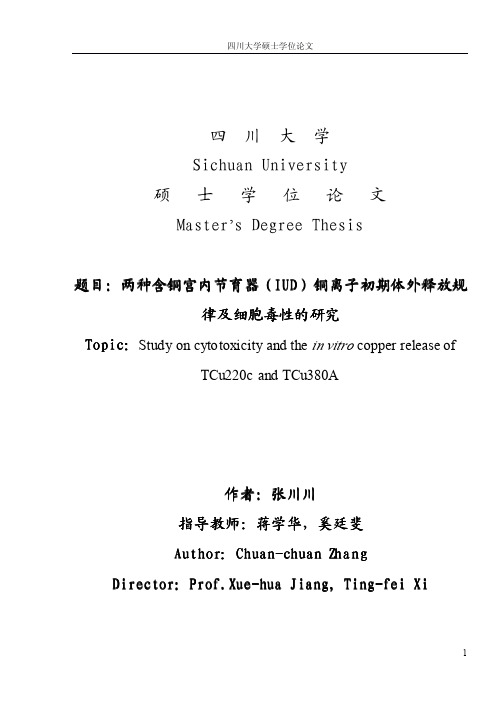
1
四川大学硕士学位论文
摘要
两种含铜宫内节育器(IUD)铜离子初期体外释放规 律及细胞毒性的研究
药剂学专业
研究生:张川川 指导教师:蒋学华,奚廷斐
4
Abstract
四川大学硕士学位论文
Study on cytotoxicity and the in vitro copper release of TCu220c and TCu380A
Major: Pharmaceutics Science Student: Chuanchuan Zhang, Professor: Xue-hua Jiang, Ting-fei Xi
因此,在临床应用中,建议进一步结合实践,全面考察两种含铜宫内节育 器的不良事件,由暴释现象引起的置器后的不适和异常出血等副作用的发生率, 带器妊娠的发生率等,以明确不同含铜面积的宫内节育器的毒性问题。词:宫内节育器,TCu220c ,TCu380A,细胞毒性,细胞周期,细胞凋亡
5
四川大学硕士学位论文
first day, which is 10 times higher than that of TCu220c (~38μg/d) at pH 5.8 on the third day. Copper release depends on the pH value of the SUS, the copper surface area of the Cu-IUD and the behavior of the copper surface finish. In genera l, the most important change of decreases in the corrosion rate took place during the first 15 days of the exper iment; and then the corrosion rate drops dramatica lly, and a steady state of corrosion was observed. This behavior has been attributed to a protective effect of the deposition la yers formed on copper. SEM showed the deposition la yers formed on the TCu-IUD and P, Cl, Ca, Na, K and Cu signa ls were defined by EDX in the corrosion product la yers. And as the pH value decreased,the ratio of Cu decreased which was opposite to the ratio of C、Ca、O.
四川大学材料学院硕博士学位论文查重及送审申请表

四川大学材料学院硕/博士学位论文查重及送审申请表
本人姓名,学号,专业
学位论文:《》本人学位论文经导师同意已定稿,特申请对论文进行形式审查(查重)并提交评审。
本人已经认真阅读了《四川大学博士学位论文质量监督管理办法》和《四川大学材料科学与工程学院博士学位论文质量监督管理细则》文件。
已经知晓:
1.博硕士学位论文形式审查(查重)检测结果重合率未超过10%的,可正常
进入送审环节,其中超过5%的,需导师出具说明并签字确认。
2. 博硕士学位论文形式审查(查重)检测结果重合率超过10%,但未超过20%的,可允许修改论文后再次提交形式审查。
3. 博硕士学位论文形式审查(查重)检测结果重合率超过20%的,需至少修改论文5个月以后才能重新提交查重。
4.凡盲审的博硕士学位论文,查重通过后需先提交学院经两名专家预审。
两份预审结果均达良好及以上者,才能正式送审。
否则,需修改后再次送预审,若第二次预审结果仍达不到良好及以上,则要求至少修改3个月后才能重新提交申请,学院重新组织预审。
本人保证提交到学院进行形式审查(查重)和提交评审的学位论文版本是经过导师定稿并同意提交的正式版本。
本人及导师已经知晓文件中关于学位论文评审专家评阅结果处理的相关规定。
申请人(签名):
导师(签名):
年月日。
四川大学研究生毕业学术论文

四川大学研究生毕业学术论文研究生是高等教育的一种学历,具有研究生学历的人。
下面是小编精心推荐的四川大学研究生毕业学术论文,希望你能有所感触!四川大学研究生毕业学术论文篇一我国学位与研究生教育的回顾与展望摘要:在我国学位条例颁布与实施30周年之际,回顾了我国学位与研究生教育发展的历程,展望了我国学位与研究生教育未来的发展,寄希望于我国从学位与研究生教育的大国成为研究生教育的强国。
关键词:学位条例学位研究生教育回顾与展望我国颁布与实施学位条例已三十个年头。
在这三十年当中,我国学位与研究生教育发生了翻天覆地的变化。
我们经历了这三十年的完整过程,这种日新月异的变化历历在目。
同时也感受到学位与研究生教育在我国经济建设与社会进步中发挥出了巨大的推动作用。
总的来看,我国颁布与实施学位条例三十年可以分为三个十年。
第一个十年是学位与研究生教育的探索阶段,探索学位与研究生教育管理体系,规范学位与研究生教育管理制度;第二个十年是学位与研究生教育的改革阶段,改革学位与研究生教育培养制度,扩大高等学校办学的自主权;第三个十年是学位与研究生教育的发展阶段,构建有效的发展与调节机制,适应国家经济建设与社会发展的需要。
尽管这些阶段之间互相交错,但宏观地来讲贯穿着这样一个大的趋势,学位与研究生教育在社会进步中健康发展着。
一、探索与规范学位研究生教育管理制度我国经历了“十年动乱”,高等教育遭受到严重破坏。
78年全国科学大会迎来了科学的春天,并开始招收第一批硕士生,81年开始实施《中华人民共和国学位条例》。
尽管我国在解放前后也招过研究生,但那时规模很小,管理分散,即使有些有关规定也是零零散散,各学校执行的也不一致。
应当说《中华人民共和国学位条例》是我国学位与研究生教育的第一部完整的法律。
因此在最初的十年里是探索与完善由学位条例规范的学位制度。
这个十年的基本特征是稳定规模,建全制度,规范管理,提高质量。
在这一个阶段里各个学校基本上不要求扩大规模,而是把重点放在制度、管理与培养质量上。
四川大学工程硕士学位论文很大的它...

5.况梅.付建平资源型城市攀枝花文化创新研究[期刊论文]-集团经济研究2007(26)
6.周海林.樊平.ZHOU Hai-lin.FAN Ping攀枝花市资源利用与可持续发展战略研究[期刊论文]-资源科学
2000,22(1)
7.黄旭.李一平.王峰.杜成勋攀枝花市气候特点与冬季光热资源开发[期刊论文]-四川气象2006,26(1)
8.冯长春攀枝花烟草病毒病综合防治技术探索与研究[学位论文]2010
9.涂维攀枝花城区水土流失影响因子及防治措施研究[学位论文]2007
10.王朝芬中国特色社会主义建设道路的成功探索与实践——从攀枝花开发建设看我国改革开放进程[期刊论文]-中共银川市委党校学报2009,11(1)
31.文伏波.陈俊府对长江流域生态环境建设的认识与思考[期刊论文]-水利水电技术 2004(1)
32.陈俊合.刘树锋.黄春苑城镇体系规划中的生态与环境保护规划--以潮州市为例[期刊论文]-资源开发与市场2004(2)
33.邓睿浅议西双版纳的生态环境保护和建设 2004(z1)
34.吴晓军.祖廷勋近年来西部生态环境保护的对策与措施研究综述[期刊论文]-甘肃社会科学 2001(2)
39.胥慧芹.姚建.田静大邑县生态示范区的生态旅游开发与建设[期刊论文]-四川环境 2003(4)
40.姚建.艾南山.刘国东试论区域环境综合整治研究新途径--环境重塑[期刊论文]-中国环境科学 2001(6)
41.攀枝花统计年鉴 1999
1.王萍攀枝花干热河谷保水保墒造林技术研究[学位论文]2008
本文链接:/Thesis_Y846828.aspx
四川大学 硕士毕业论文

四川大学硕士毕业论文四川大学硕士毕业论文近年来,四川大学作为中国西南地区一所知名的高等学府,其硕士毕业论文的质量和研究水平备受关注。
本文将从不同的角度探讨四川大学硕士毕业论文的特点和研究成果,以及对学术界和社会的影响。
一、研究领域的广度四川大学作为一所综合性大学,拥有众多学科领域的研究优势。
硕士毕业论文的研究领域涵盖了自然科学、工程技术、医学、社会科学等多个领域。
不同领域的研究成果为学术界提供了丰富的知识资源,也为社会发展提供了智力支持。
以自然科学领域为例,四川大学的硕士毕业论文在生物学、化学、地理学等方面都取得了重要的研究成果。
例如,在生物学领域,有关生物多样性保护、遗传学等方面的研究成果为生物资源的保护和利用提供了科学依据。
在地理学领域,研究成果涉及到地理信息系统、自然灾害风险评估等方面,为地方政府的决策提供了重要参考。
二、研究方法的创新性四川大学的硕士毕业论文在研究方法上也表现出一定的创新性。
研究者们不断探索新的研究方法,以提高研究的准确性和可靠性。
例如,在社会科学领域,研究者们采用问卷调查、实地观察、深度访谈等方法,以获取真实可靠的研究数据。
在工程技术领域,研究者们运用模拟实验、计算机仿真等技术手段,以验证研究假设和推导结论。
研究方法的创新性不仅提高了研究成果的科学性,也为学术界提供了新的思路和方法。
这些创新的研究方法在学术界产生了积极的影响,也为相关领域的研究提供了借鉴。
三、研究成果的社会影响四川大学的硕士毕业论文不仅在学术界产生了影响,也对社会产生了积极的影响。
研究成果的应用和推广,为社会发展提供了有益的参考和支持。
以医学领域为例,四川大学的硕士毕业论文在医学诊断、药物研发等方面取得了重要的研究成果。
这些成果的应用,为医疗技术的提升和疾病的治疗提供了新的思路和方法。
同时,研究成果的推广,也为医疗机构和患者提供了更好的医疗服务和健康管理。
此外,在工程技术领域,四川大学的硕士毕业论文也为社会发展做出了重要贡献。
四川大学硕士学位论文

四川大学硕士学位论文题目基于Power mode图像和骨架算法的血管直径测量方法作者李硕完成日期2009 年04 月01日培养单位四川大学指导教师刘东权教授专业计算机应用研究方向计算机应用授予学位日期年月日基于Power mode图像和骨架算法的血管直径测量方法计算机应用研究生:李硕指导教师:刘东权在临床医学领域里,很多情况下医生希望测量病人血管的直径。
它们对于很多病情的诊断,如冠心病、肝硬化等,起到了至关重要的作用。
随着计算机硬件技术的飞速发展,我们可以利用图像处理技术更方便地利用血管图像来帮助医生测量血管直径。
进年来发展出的3D超声技术可以提供给我们更多的血管信息。
Power mode 图像相比传统的B模式超声图像和多普勒彩色血流图(CFM),高信噪比的优点。
而且它还具有可选观察角度,易于从背景中分割出来等特性,因此非常适合作为血管测量用图。
本文给出了一个基于3D Power mode图像计算血管直径的方案:先将3D Power mode图像转化成二值图像,然后提取二值图像中血管的边界和中线,然后对中线上任意一点找到其切线,最后找到切线过这点的垂线,垂线与边界相交于两点之间的距离记为此中线点处的直径。
整个方案框架中如何找到一条连续,准确,理想的中线,是重点与难点,它决定了最终测量结果的准确性。
而且由于血管形状复杂,边界不光滑,又有很多分支,就更加大了中线提取的难度。
所以作者对此进行了深入的研究。
在计算机视觉技术里有一类算法,是用来提取数字图像中某个或某些物体的中轴线,以便用来表征物体的拓扑结构,或作为物体识别的特征。
我们称这类算法为骨架算法。
有些文献也将其称为中轴变换,或细化算法。
已经有大量的文献,基于不同思想,对骨架算法进行了各种实现和改进。
这些方法的运算复杂度,得出的结果以及适用的情形都不尽相同。
最常见的细化法,利用一些判断条件不断删除目标物体边界点,最后剩下骨架点,适用于成条状,带状物体的骨架提取,如文字,指纹;基于数学形态学的开操作和腐蚀操作“沉淀出”目标物体骨架的算法,适用于寻找物体特征点,并可以从骨架重建出原物体来;基于目标物体欧式距离变换图提取出的骨架,拓扑结构较准确;利用几何里物体最大内切圆的概念寻找骨架点的方法,运算简单,速度快;等等。
- 1、下载文档前请自行甄别文档内容的完整性,平台不提供额外的编辑、内容补充、找答案等附加服务。
- 2、"仅部分预览"的文档,不可在线预览部分如存在完整性等问题,可反馈申请退款(可完整预览的文档不适用该条件!)。
- 3、如文档侵犯您的权益,请联系客服反馈,我们会尽快为您处理(人工客服工作时间:9:00-18:30)。
四川大学硕士学位论文题目基于Power mode图像和骨架算法的血管直径测量方法作者李硕完成日期2009 年04 月01日培养单位四川大学指导教师刘东权教授专业计算机应用研究方向计算机应用授予学位日期年月日基于Power mode图像和骨架算法的血管直径测量方法计算机应用研究生:李硕指导教师:刘东权在临床医学领域里,很多情况下医生希望测量病人血管的直径。
它们对于很多病情的诊断,如冠心病、肝硬化等,起到了至关重要的作用。
随着计算机硬件技术的飞速发展,我们可以利用图像处理技术更方便地利用血管图像来帮助医生测量血管直径。
进年来发展出的3D超声技术可以提供给我们更多的血管信息。
Power mode 图像相比传统的B模式超声图像和多普勒彩色血流图(CFM),高信噪比的优点。
而且它还具有可选观察角度,易于从背景中分割出来等特性,因此非常适合作为血管测量用图。
本文给出了一个基于3D Power mode图像计算血管直径的方案:先将3D Power mode图像转化成二值图像,然后提取二值图像中血管的边界和中线,然后对中线上任意一点找到其切线,最后找到切线过这点的垂线,垂线与边界相交于两点之间的距离记为此中线点处的直径。
整个方案框架中如何找到一条连续,准确,理想的中线,是重点与难点,它决定了最终测量结果的准确性。
而且由于血管形状复杂,边界不光滑,又有很多分支,就更加大了中线提取的难度。
所以作者对此进行了深入的研究。
在计算机视觉技术里有一类算法,是用来提取数字图像中某个或某些物体的中轴线,以便用来表征物体的拓扑结构,或作为物体识别的特征。
我们称这类算法为骨架算法。
有些文献也将其称为中轴变换,或细化算法。
已经有大量的文献,基于不同思想,对骨架算法进行了各种实现和改进。
这些方法的运算复杂度,得出的结果以及适用的情形都不尽相同。
最常见的细化法,利用一些判断条件不断删除目标物体边界点,最后剩下骨架点,适用于成条状,带状物体的骨架提取,如文字,指纹;基于数学形态学的开操作和腐蚀操作“沉淀出”目标物体骨架的算法,适用于寻找物体特征点,并可以从骨架重建出原物体来;基于目标物体欧式距离变换图提取出的骨架,拓扑结构较准确;利用几何里物体最大内切圆的概念寻找骨架点的方法,运算简单,速度快;等等。
本文第一部分首先提出科研问题和科研背景,然后提出了一套解决方案,并概要地介绍了方案中用到的两个核心技术,Power mode图像和骨架算法。
第二部分对骨架算法进行了深入地研究,并于最后提出了一个基于欧式距离图,距离图梯度信息和最短路径思想的算法。
最后一个部分介绍了作者在进行研究过程中看到的骨架算法在其他很多领域里的重要应用。
简要地整理介绍出来,希望能对从事相关工作的读者有所帮助。
关键词:血管直径测量骨架算法形态学细化距离变换计算机视觉3D Power modeBlood Vessel Tracking and Diameter MeasurementMethod Based on Skeleton AlgorithmMajor:Computer ApplicationGraduate:Li Shuo Advisor:Dongc LiuIn clinic medicine field, doctors tend to know patients’ blood vessel diameter in many situations, since they are very helpful to the diagnoses of many diseases, such as coronary heart disease, hepatocirrhosis and so on. With the fast development of computer hardware, we can take use of digital image processing techniques to help doctors to measure the blood vessel diameter conveniently.3D ultrasound techniques, which developed recently, can provide us much information about blood vessel. 3D Power mode image has much higher signal-to-noise ratio (SNR) comparing to traditional B mode ultrasound image and Doppler color flow map (CFM). Also it is angle dependence. What is more, blood flow can easily be extracted from background in 3D power mode image, so it is a very good choice for blood vessel diameter measurement.This paper presents a solution to calculate vessel’s diameter based on 3D power mode images: first transfer 3D Power mode image into binary image, then extract the binary image’s boundary and midline; after that, for each point on the midline, we find the tangent and the Perpendicular Line of the tangent through that midline point, the perpendicular line and the boundary intersect into two points, the distance between those two points are the diameter of the vessel on that given midline point.In this solution, the key is to find a continuous, exact, and one pixel wide midline, since it will affect the veracity of the final measurement. However, the structures of the vessels are usually very complicate, and the boundary is not smooth, which increase the difficulty of extracting the midline. Sowe will pay more attention on this part.In computer vision field, there is a class of algorithms which are used to extract objects’ midline from the digit image, so that objects’ topology structure can be well expressed or objects’ feature can be better found out. They are called skeleton algorithm, or in some other literature, thinning or midline transform.Based on different ideas and situations, thousands of papers have presented many kinds of achievements and improvements on skeleton algorithm, during which, the complexity of calculation, getting results and suitable situation are different. The most frequently used method, thinning, which takes use of some boundary condition judgments to delete boundary points layer by layer and leaves the skeleton points in the end, is more suitable for the extraction of strip objects’ skeleton, such as handwriting, and fingerprints. The methods that based on mathematics morphology’s open and erosion op eration, are more suitable for looking for objects’ feature points, and also can be used to trace objects back from their skeleton points. Methods based on Euclidean distance map of objects can get skeletons with more accurate geometry topology. Methods that take use of objects’maximum inside tangent circles are much easier to calculate, and usually run fast.The first part of the article is an introduction of the research topic and research background, the solution structure of the problem and two core techniques used for the problem solving: Power mode image and skeleton algorithm.In the second part, we did some deep research on the skeleton algorithm. And also present a skeleton algorithm based on Euclidean Distance Map, gradient information of that map and the shortest path algorithm. The results show that it is very good to represent vessel’s structure.In the last part of the article, we will introduce the application of skeleton algorithm in other fields. Hopefully it is helpful to readers in other fields.Key words:Measurement of Vessel Diameter, Skeleton Algorithm, Thinning, Mathematics Morphology, Distance Transform, 3D Power mode.。
